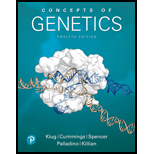
Each year in the United States, there are over 230,000 new cases of prostate cancer and almost 28,000 deaths. A 3.8-Mb region on chromosome 8 (8q24), called a gene desert, has very few genes but contains enhancer sequences that potentially confer significant risks for prostate cancer. One particular enhancer allele, which is known to be associated with an elevated risk for prostate cancer, physically interacts with the promoter region of the nearby MYC gene and facilitates its upregulation. Overexpression of MYC, which encodes a cell-cycle regulatory protein, is observed in multiple types of cancer (see Chapter 24). The risk allele has a frequency of 49 percent in men of European descent and 81 percent in men of African ancestry. Most of the differential MYC activity associated with the risk allele occurs during prenatal development, raising the possibility that testing for this allele early in life can be used to identify those in the African-American population who are at very high risk for prostate cancer. However, researchers cannot rule out the possibility that this enhancer causes overexpression of other genes, which may also be involved in prostate cancer.
If a screening test for the risk allele is developed, the test could show that the risk allele is not present, and MYC activity would be normal. However, someone can receive a negative result from this test but still have a higher than normal risk for prostate cancer from other mutations that contribute to cancer risk. What ethical concerns are there with using a test for cancer susceptibility that is focused on only one risk allele?
Want to see the full answer?
Check out a sample textbook solution
Chapter 17 Solutions
Concepts of Genetics (12th Edition)
- Noggin mutation: The mouse, one of the phenotypic consequences of Noggin mutationis mispatterning of the spinal cord, in the posterior region of the mouse embryo, suchthat in the hindlimb region the more ventral fates are lost, and the dorsal Pax3 domain isexpanded. (this experiment is not in the lectures).a. Hypothesis for why: What would be your hypothesis for why the ventral fatesare lost and dorsal fates expanded? Include in your answer the words notochord,BMP, SHH and either (or both of) surface ectoderm or lateral plate mesodermarrow_forwardNot part of a graded assignment, from a past midtermarrow_forwardNot part of a graded assignment, from a past midtermarrow_forward
- please helparrow_forwardWhat does the heavy dark line along collecting duct tell us about water reabsorption in this individual at this time? What does the heavy dark line along collecting duct tell us about ADH secretion in this individual at this time?arrow_forwardBiology grade 10 study guidearrow_forward
 Biology 2eBiologyISBN:9781947172517Author:Matthew Douglas, Jung Choi, Mary Ann ClarkPublisher:OpenStax
Biology 2eBiologyISBN:9781947172517Author:Matthew Douglas, Jung Choi, Mary Ann ClarkPublisher:OpenStax Biology Today and Tomorrow without Physiology (Mi...BiologyISBN:9781305117396Author:Cecie Starr, Christine Evers, Lisa StarrPublisher:Cengage Learning
Biology Today and Tomorrow without Physiology (Mi...BiologyISBN:9781305117396Author:Cecie Starr, Christine Evers, Lisa StarrPublisher:Cengage Learning Human Heredity: Principles and Issues (MindTap Co...BiologyISBN:9781305251052Author:Michael CummingsPublisher:Cengage Learning
Human Heredity: Principles and Issues (MindTap Co...BiologyISBN:9781305251052Author:Michael CummingsPublisher:Cengage Learning Biology (MindTap Course List)BiologyISBN:9781337392938Author:Eldra Solomon, Charles Martin, Diana W. Martin, Linda R. BergPublisher:Cengage Learning
Biology (MindTap Course List)BiologyISBN:9781337392938Author:Eldra Solomon, Charles Martin, Diana W. Martin, Linda R. BergPublisher:Cengage Learning Biology: The Dynamic Science (MindTap Course List)BiologyISBN:9781305389892Author:Peter J. Russell, Paul E. Hertz, Beverly McMillanPublisher:Cengage Learning
Biology: The Dynamic Science (MindTap Course List)BiologyISBN:9781305389892Author:Peter J. Russell, Paul E. Hertz, Beverly McMillanPublisher:Cengage Learning BiochemistryBiochemistryISBN:9781305577206Author:Reginald H. Garrett, Charles M. GrishamPublisher:Cengage Learning
BiochemistryBiochemistryISBN:9781305577206Author:Reginald H. Garrett, Charles M. GrishamPublisher:Cengage Learning





